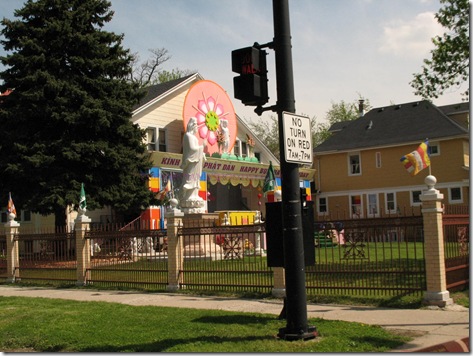Finding the Many in the One
We’re pleased to
announce that today’s post comes from our newest contributing editor, Chris Cantwell. Chris has long haunted the blog as an occasional contributor and
self-promoter, so we’re happy to have him aboard in an official capacity. Chris
is currently the Assistant Director of the Dr. William M. Scholl Center forAmerican History and Culture at the Newberry Library in Chicago. His research focuses
on American evangelicals, and he’s currently revising a manuscript that uses
the life of a turn-of-the-twentieth-century Bible class teacher who
simultaneously self-identified as a fundamentalist and ran for political office
as a Socialist as a window through which to reinterpret the movement’s origins.
Here, he reflects on teaching American religious history based on his current
work at the Newberry.
 |
| Backyard Buddhism at the Chua Truc Lam Temple |
Every weekday morning I ride my bike down Chicago’s scenic
Lake Shore Trail to the top of the Magnificent Mile where the Newberry resides.
But before I can hit the trail, I have to navigate a busy urban
thoroughfare among motorists who think bike paths are really tiny passing lanes.
Though hairy, my ride down this street is short—just over two miles. But in
this short span Chicago’s religious diversity, indeed, America’s religious
diversity, is amazingly unveiled. In just over twenty blocks I pass by a classic
Catholic parish, a fundamentalist Presbyterian church, two socially
conservative Lutheran churches, two leftist evangelical communes, an affirming Episcopal
church, a festive Vietnamese Buddhist temple, an American Indian Center, a
Christian Science reading room, a Taoist society, a yoga center, a black
Baptist church, and a Methodist congregation of African émigrés. It’s a bit of
a comfort to know that if I were to meet my demise on Wilson Avenue, at least
one doorway to the divine is only a step away.
And as goes the city, so goes the nation. Regardless of
where one situates its “origins,” America has been a crucible of religious
contact and collision from the beginning. Catholics, Jews, Muslims, myriad Native American
communities, and a plethora of Protestant sects who looked upon everyone with
varying degrees of suspicion and disdain called the continent home long
before the Constitution’s ratification. I’ve noticed, however, that we often
teach and write about this history less from the standpoint of America’s
religious plurality and more from the standpoint of American religious
hegemony. “Great Awakenings,” “Benevolent Empires,” or “Evangelical Centuries”
are often the themes of our textbooks and curricular units. And rightly so. These
tectonic religious movements have, without question, shaped the contours of
American life. But they were never without their alternatives, and recent demographic data suggests we are approaching a moment that could reframe American
history as the rise of religious diversity rather than the end of Protestant
hegemony. If this is the case, how will we teach this new narrative?
This past week, the Scholl Center launched a year-long
project that hopes to explore this very question. The program, titled “Out of Many: Religious Pluralism in America,” has gotten some attention on the blog before, but the project is now in full swing. Last week, twenty community
college faculty gathered at the Newberry for a week of
morning seminars and afternoon research to design curriculum that anchors the
American experience in the diversity of its religious life. We were treated to morning seminars from Tisa Wenger, Kevin Schultz, and Aziz Huq, as well as an evening lecture by Martin Marty. I’ll be sure to blog
about the results of our endeavors over the course of the next year, but for
now I want offer a reflection on the first week’s major themes. First, I was struck
how every visiting scholar emphasized integrating study of
the First Amendment into our teaching and research. Tisa discussed how the
statute is a kind of theological concept for many Protestants, while Aziz noted
that students often find discussions of the Amendment’s Free Exercise clause to
be more revealing than the more divisive history of the Establishment Clause. Second,
every discussion always circled back to defining the “religious” in America’s
religious history. Because let’s be honest: “pluralism” is as much a proscriptive
term as a descriptive one, and we have to remain sensitive to the ways in which
America’s promotion of religious freedom always entails a contest over the
definition of religion. Finally, and somewhat paradoxically, was the surprising
role of cooperation in our discussions. True, America’s religious diversity has
been an almost constant source of tensions and conflict. But it has also been
the source of innovative interfaith cooperation. This was Martin Marty’s
strongest point. We are a nation of encounters, he argued. So where is the
place of interfaith relations in American religious history?
We certainly didn’t answer these questions. Over the course
of the next year, however, we hope to contribute to a discussion by
finding ways to integrate the study of religious pluralism into humanities
classrooms everywhere. This way, the curriculum of our classrooms can more
accurately reflect the diversity of the streets upon which many of our students
live.

Comments